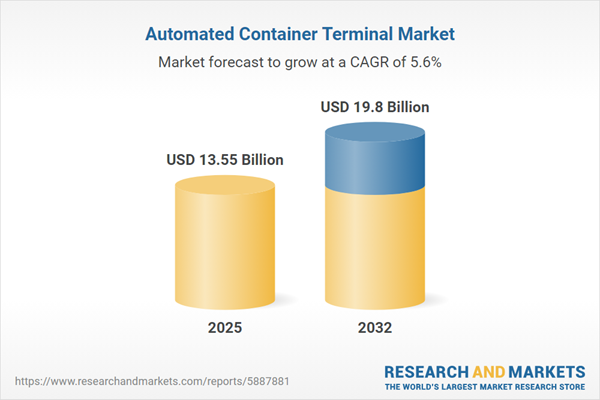Speak directly to the analyst to clarify any post sales queries you may have.
The Automated Container Terminal Market empowers port operators to achieve greater efficiency and resilience through advanced automation and digital solutions, facilitating streamlined logistics in a continuously evolving global landscape.
Market Snapshot: Automated Container Terminal Market Overview
The automated container terminal market is positioned for sustained growth through 2032, driven by increased investments in automation and evolving regulatory frameworks. As port operators prioritize digital transformation and workplace safety, the adoption of robotics, digital platforms, and sustainable operations is accelerating. Modernization efforts support business continuity and help companies manage shifting global trade dynamics. The diverse operational requirements and compliance standards across regions present both opportunities and challenges, highlighting the strategic advantage of localized approaches for technology integration.
Scope & Segmentation of the Automated Container Terminal Market
This segmentation outlines key operational, technological, and regional factors shaping market adoption, providing senior executives with clear pathways for investment and deployment:
- Application: Automated container terminal solutions are relevant for both seaport and inland terminal environments, enabling efficient cargo management and infrastructure optimization across varied logistics hubs.
- Type: Systems encompass semi-automated and fully automated models, allowing operators to align technology selection with their modernization stage and asset strategies for scalable transformation.
- Service: Consulting, installation, and maintenance services are essential to sustaining uptime, maximizing system value, and extending equipment life throughout the automation journey.
- Operation Mode: Automation and remote-control capabilities give ports real-time oversight, agile management, and improved decision-making at all levels of facility operations.
- Automation Level: Adoption varies according to the degree of technology integration, from augmenting legacy systems to full digital migration, enabling operators to balance transformation risk with operational continuity.
- End User: Sectors such as automotive, chemicals, oil, and gas rely on these solutions to maintain high throughput and reliable supply flows amid demanding conditions.
- Component: Critical elements include automated guided vehicles (AGVs), gantry cranes, shuttle carriers, advanced sensors, and analytics, which enhance visibility and resource efficiency across terminal operations.
- Geographical Coverage: The market includes the Americas, Europe, Middle East and Africa, and Asia-Pacific, where technology adoption is shaped by regional policies, supply chain priorities, and compliance standards.
- Company Coverage: Major players such as Cargotec Corporation, Konecranes Plc, ABB Ltd., Siemens AG, China Zhenhua Heavy Industries, Daifuku Co., Mitsubishi Heavy Industries, Toshiba Infrastructure, Hyundai Heavy Industries, and Kawasaki Heavy Industries drive innovation and industry benchmarks in this space.
Key Takeaways for Senior Decision-Makers
- Terminal automation empowers operational teams to respond flexibly to changing cargo flows, improving service reliability while minimizing workflow disruptions.
- Integration of advanced robotics and artificial intelligence raises safety standards and supports compliance with regional and global regulatory protocols.
- Adoption of modular automation enables phased modernization, reducing the risks and costs associated with comprehensive system upgrades in diverse operational environments.
- Deployment of electrification and resource management initiatives extends sustainability practices, supporting both environmental targets and ongoing cost-containment goals.
- Local technology partnerships facilitate alignment with regulatory requirements and assist in developing tailored automation strategies for distinct market contexts.
- Open-architecture platforms encourage seamless workflow coordination, which increases efficiency across multi-site or networked terminals while easing integration of future technologies.
Tariff Impact Across Automated Container Terminal Supply Chains
Recent adjustments to United States tariffs have directly influenced supply chain strategies in the automated container terminal market, particularly in sourcing equipment such as robotic gantries and sensors. Operators are responding by expanding domestic procurement options and forming new strategic alliances. This approach helps maintain innovation momentum and operational stability as trade policies and cross-border regulations evolve.
Methodology & Data Sources
This report draws insights from direct interviews with industry experts, rigorous examination of technical and regulatory documentation, and proven methodologies such as data triangulation and scenario modeling. The resulting analysis offers senior executives trustworthy benchmarks for decision-making.
Why This Report Matters for Senior Decision-Makers
- Delivers actionable segmentation and competitive analysis, equipping leaders to anticipate market developments and evaluate organizational readiness for automation adoption.
- Provides practical guidance to navigate regulatory shifts and manage compliance within dynamic global and regional tariff environments.
- Outlines systematic pathways for technology modernization to minimize operational risk and support long-term strategic growth.
Conclusion
This report equips senior decision-makers with targeted insights to advance port modernization, drive efficiency, and manage operational resilience as supply chains and business needs evolve.
Additional Product Information:
- Purchase of this report includes 1 year online access with quarterly updates.
- This report can be updated on request. Please contact our Customer Experience team using the Ask a Question widget on our website.
Table of Contents
3. Executive Summary
4. Market Overview
7. Cumulative Impact of Artificial Intelligence 2025
Companies Mentioned
The companies profiled in this Automated Container Terminal market report include:- Cargotec Corporation
- Konecranes PLC
- ABB Ltd.
- Siemens AG
- China Zhenhua Heavy Industries Co., Ltd.
- Daifuku Co., Ltd.
- Mitsubishi Heavy Industries, Ltd.
- Toshiba Infrastructure Systems & Solutions Corporation
- Hyundai Heavy Industries Co., Ltd.
- Kawasaki Heavy Industries, Ltd.
Table Information
| Report Attribute | Details |
|---|---|
| No. of Pages | 188 |
| Published | November 2025 |
| Forecast Period | 2025 - 2032 |
| Estimated Market Value ( USD | $ 13.55 Billion |
| Forecasted Market Value ( USD | $ 19.8 Billion |
| Compound Annual Growth Rate | 5.5% |
| Regions Covered | Global |
| No. of Companies Mentioned | 11 |









